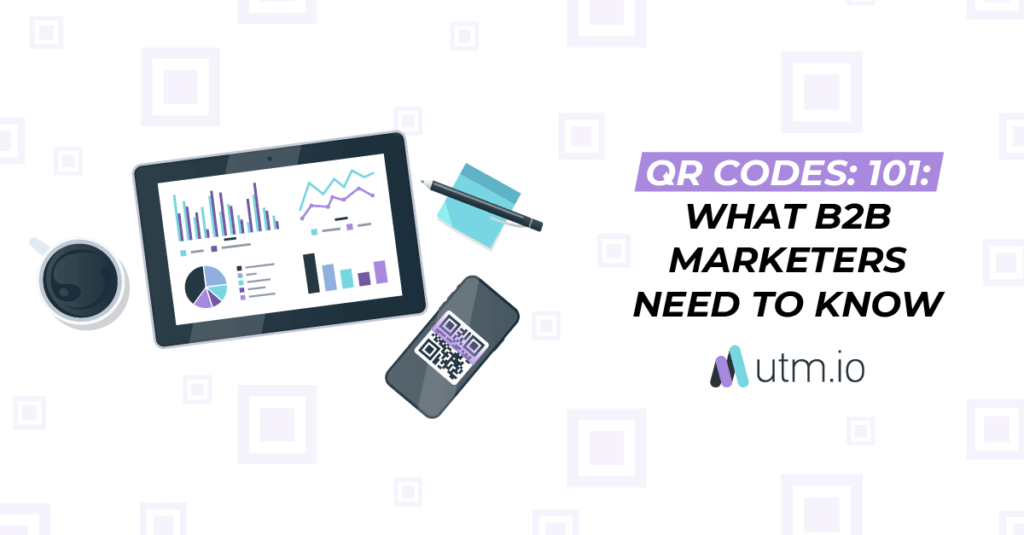QR codes aren’t just for restaurant menus anymore.
They’ve become one of the simplest, fastest ways to connect offline experiences to digital ones. And for B2B marketers (especially those running events, field campaigns, or print collateral) that’s a big deal.
When paired with UTM parameters, QR codes don’t just drive traffic. They give you clean attribution. They make physical marketing measurable. And they help you prove what’s working across every channel.
So let’s dig in.
Why QR Codes Matter in B2B Marketing
Once a niche tool for warehouse inventory, QR codes are now a staple of modern customer journeys.
- 97M Americans scanned a QR code in 2024 (up 42% since 2020)
- Global QR scans are up 433% since 2021
- QR code creation has increased 400% since 2021 (and 43% since 2022).
- 80% of U.S. users trust QR codes.
More importantly, B2B marketers still rank in-person events as their #1 lead driver. Beating webinars, email, and even SEO. But those offline moments can be hard to track. That’s where QR codes come in.
They create a bridge from booth to browser, from flyer to funnel. And when paired with UTMs, you’re no longer guessing how that traffic got there.
What Makes a QR Code B2B-Ready?
Most free QR generators weren’t built for marketers. And definitely not for teams.
If you want QR codes that don’t break your attribution, or your design system, look for:
- Dynamic destinations – So you can change the URL even after you’ve printed it
- Scan tracking – So you can actually measure what’s working
- Branded templates – So you stay on brand without extra design work
- Team-level permissions – So no one accidentally ships something off-brand
Spoiler: UTM.io gives you all of this in one place.
Where to Use QR Codes in B2B Campaigns
If you can print it, you can QR it. A few smart places to start:
- Business Cards – Link to your LinkedIn, About page, or a custom intro video
- Event Signage – Different codes for booth vs. main stage vs. printed swag
- Brochures & Flyers – Link to gated content, case studies, or demo booking
- Direct Mail – Personalize landing pages for VIP accounts
- Presentations – Add a code to slides or webinars to track attendees
- Print & Out-of-Home Ads – Push traffic from offline placements to measurable channels
Use UTMs to Track Every Scan
UTMs (Urchin Tracking Modules) are the secret sauce that turns your QR code from a black box into a goldmine of attribution data.
Here’s how to break down your parameters:
- utm_source=trade-show
- utm_medium=qr-code
- utm_campaign=product-launch
- utm_content=booth-signage (optional)
- utm_term=brand-colors_qr (optional)
These tags help you see exactly where your traffic came from. In Google Analytics, Segment, Amplitude, and just about any analytics tool you use.
Static vs. Dynamic QR Codes
Static QR codes always point to the same destination. Once you print it, it’s set in stone.
Dynamic QR codes let you change the destination anytime without reprinting. If you change your landing page, offer, or domain, you’re still covered.
Better yet: when dynamic codes are paired with shortened links, they stay scannable, even on small prints or older devices.
How to Track QR Code Traffic in GA4 and Segment
In GA4:
- Head to: Reports > Acquisition > Traffic Acquisition
- Use filters like Session Source/Medium or Session Campaign
In Segment:
- UTMs are captured under context.campaign
- Send to downstream tools like GA4, Amplitude, or your CRM
Bringing It All Together
If you’re still managing QR codes in a spreadsheet or generating them one at a time… it’s time to upgrade.
QR codes are now a serious channel in the B2B marketer’s toolkit. They help you:
- Track what’s working at in-person events
- Attribute ROI to print collateral
- Get more value from offline experiences
But like every other channel, they only work if the data does.
With UTM.io, you can generate dynamic, branded QR codes right where you build your campaign links. Govern templates. Track scans. And do it all at scale.
Track All Your Touchpoints (Even the Offline Ones)
Want to bring QR and UTM tracking together in your B2B marketing?
